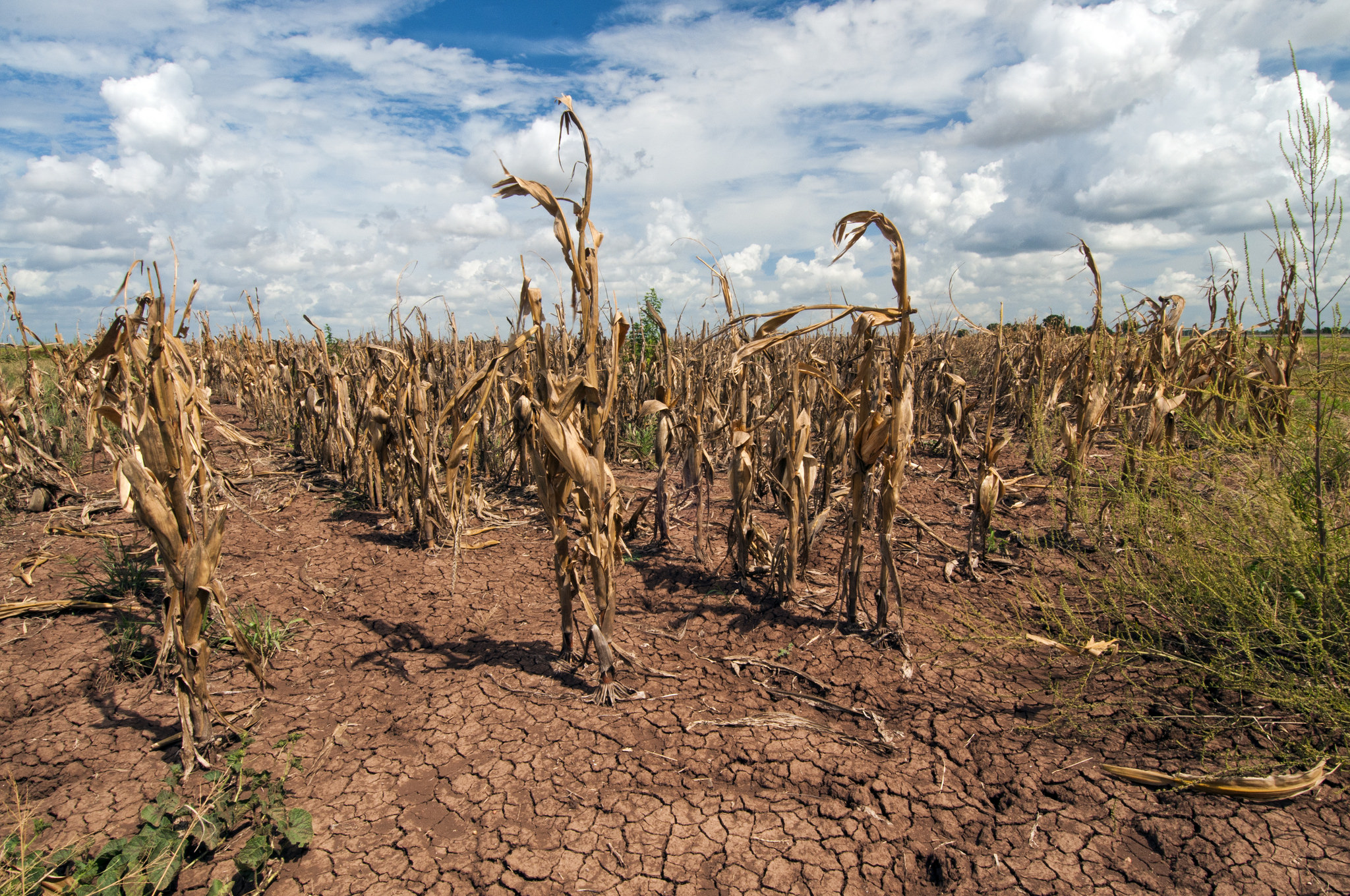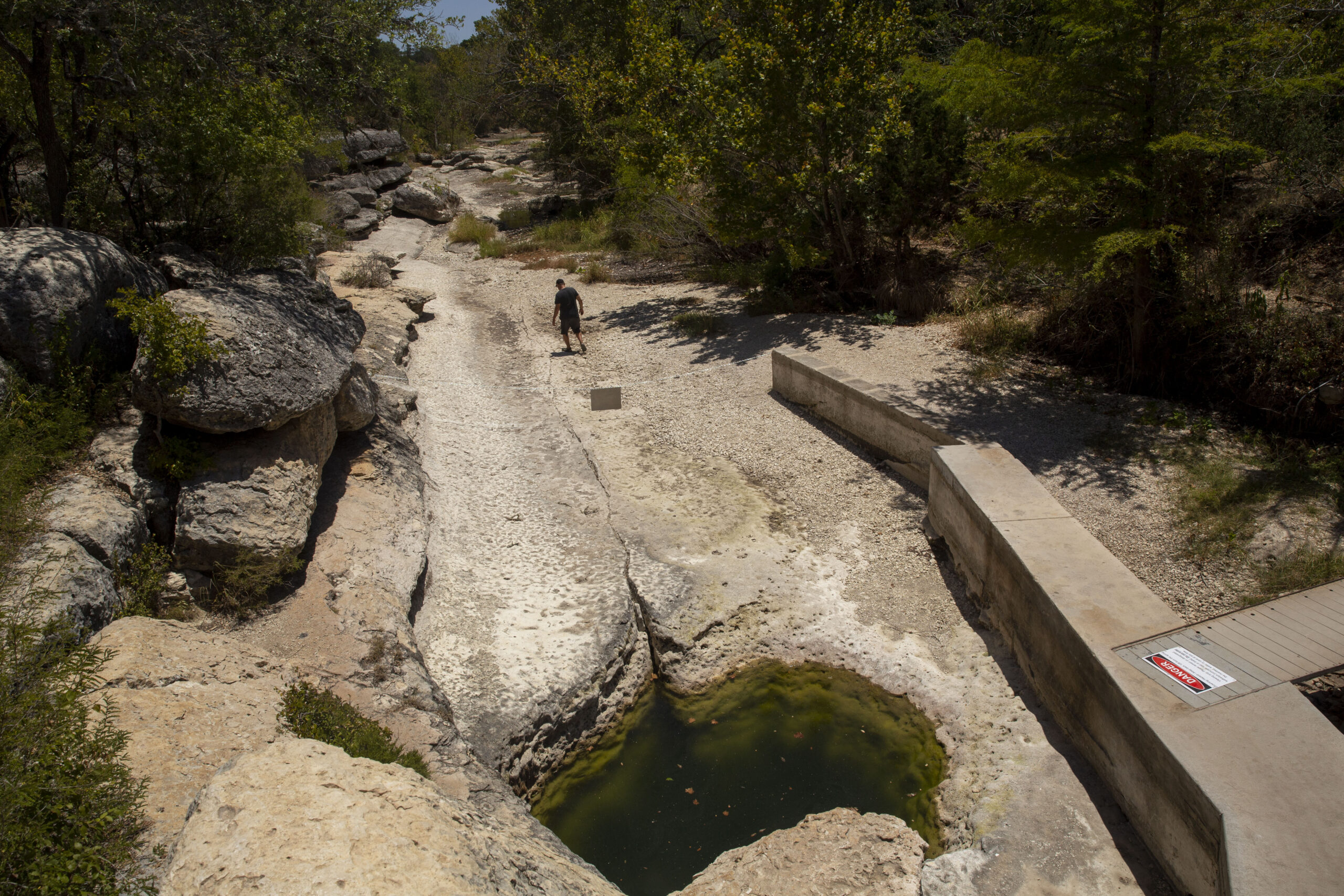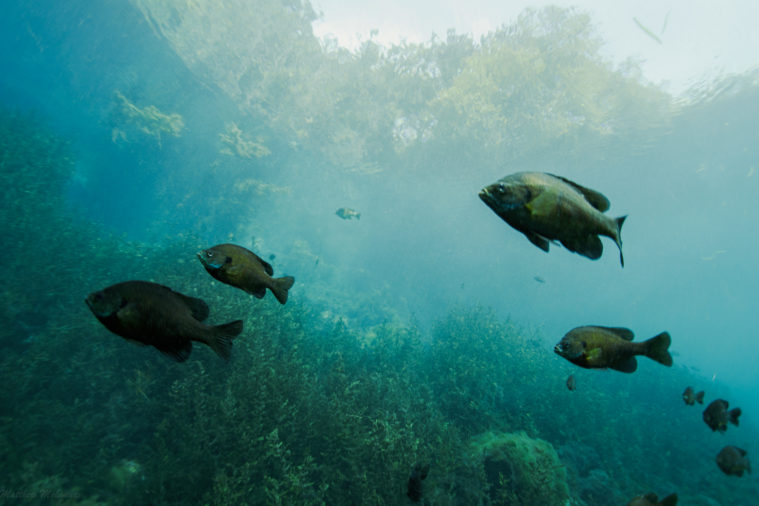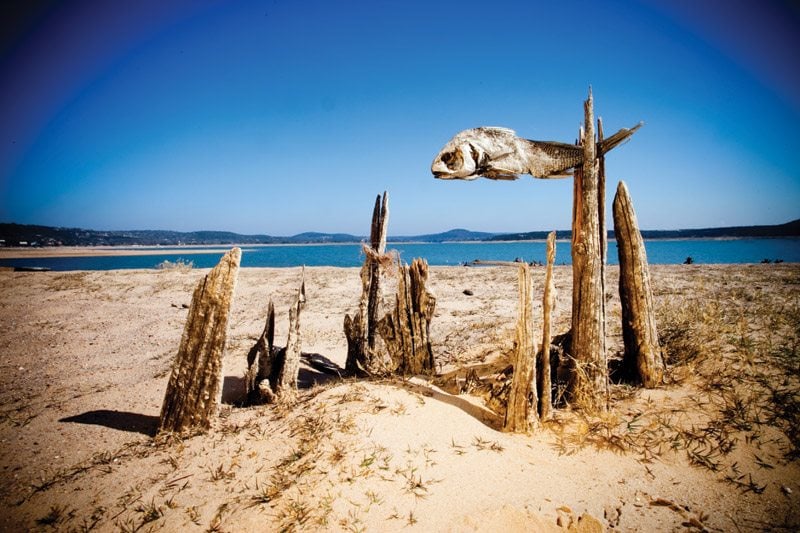
Bluffton: Texas’ Lost Civilization Rises from Lake Buchanan
A lost Texas town resurfaces in drought
A version of this story ran in the November 2012 issue.
Above: Lake Buchanan is down 26 feet.
Every civilization has its lost culture: The Romans had Pompeii; the Inca, Machu Picchu; and Central Texans, the town of Bluffton.
When Buchanan Dam was completed in 1937, the rising waters of the Colorado River submerged thousands of acres in Burnet and Llano counties. The newly formed Lake Buchanan covered the site of pecan orchards, cornfields, and the town of Bluffton. Roughly 50 families had to sell their land to the Lower Colorado River Authority and move their homes, and even graves, to higher ground.
Old Bluffton has been hidden under Lake Buchanan for most of the last 75 years, but severe droughts are bringing it back. The current drought has lowered the lake 26 feet—enough to expose the ruins of Bluffton, and enough to raise questions about the future of the Highland Lakes that symbolize both New Deal progress and a lost way of life.
Even before its scramble to evade Lake Buchanan, Bluffton was a peripatetic town. The original Bluffton was simply the homestead of the Davis family, who in the 1850s named the area after their hometown in Arkansas. The first true town of Bluffton burned in 1883. The residents moved a few miles south and rebuilt on a stagecoach line, a precursor to Highway 29 between Burnet and Llano.
Great pecan trees grew in the river valley, and the residents harvested pecans and grew corn and cotton. A cotton gin, store, and combination school and community center served the dozen families who lived in the immediate Bluffton area, along with about 40 other families in the nearby valley.
As the dam was built, the Lower Colorado River Authority began acquiring more than 20,000 acres of upriver land that would be submerged once the lake filled. LCRA staff met with local families, gauged their willingness to sell, appraised the land and made offers. In the few cases where agreement couldn’t be reached, the LCRA condemned properties. Some residents moved to yet another Bluffton, today’s tiny town about seven miles west of the doomed village, but many left the area entirely.
Former Llano County Judge Moore Johanson, who grew up in Bluffton, later wrote about the lake’s construction for a Burnet County newspaper: “We who were raised on the old Colorado River had to sacrifice our homes and land very cheap. It ruined many of us financially, but always someone has to sacrifice to make progress in our nation.”
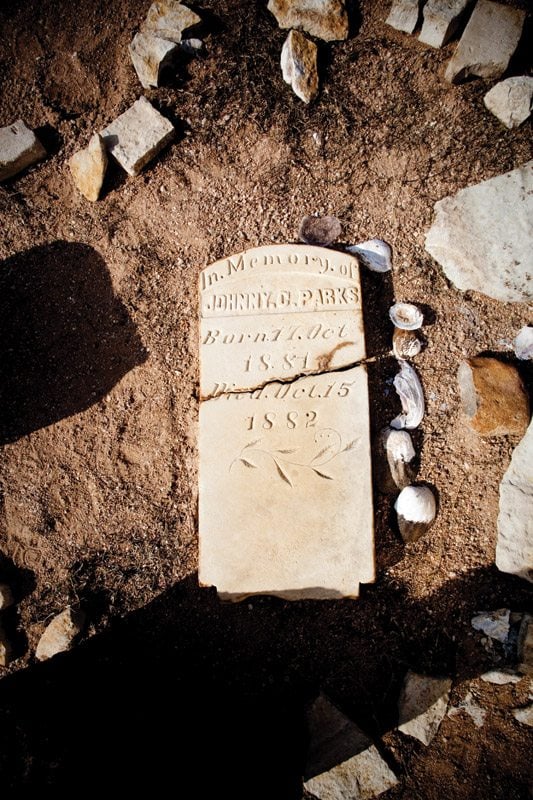
Visitors to old Bluffton today drive onto a sandy peninsula from the Llano County side of the lake. Those without four-wheel-drive vehicles take the Vanishing Texas River Cruise, an excursion that normally brings birdwatchers up the river channel, but switched to offering Bluffton tours in 2009, when drought revealed the town. The boat docks on the Bluffton peninsula, and tourists walk over low hills to the town site.
Grasshoppers spring from underfoot, and young mesquites, as tall as eight feet, bend in the breeze. The water’s been down long enough for vegetation to return.
The ruins of old Bluffton still sit on old Highway 29, where now the Jeep tracks of curiosity seekers indent the dirt. Tour guide Tim Mohan points out the foundation of the old hotel.
“You can imagine how people would stop … cool the horses down, and water them. The people would come into this building and freshen up and have lunch before they would head to Llano.”
Piles of stones and pieces of concrete foundation mark the sites of homes and the cotton gin, buildings that were moved before the water rose. A flat stretch of land was the baseball field where the Bluffton Eagles played community teams from Burnet and Llano counties.
Removing artifacts is illegal, but that hasn’t stopped visitors from walking away with bits of history when the water gets low. Mohan says that before the water went down enough for people to drive to the site—when Bluffton was an exposed island, not a peninsula—he found two intact medicine bottles and an unusual spoon. Following the LCRA’s instructions, he left the artifacts where he found them. They’ve since disappeared.
Llano County resident Alfred Hallmark found the metal part of a desk near the old school, as well as surprisingly sophisticated charcoal filtering systems in the cisterns. Hallmark has been mapping and researching old Bluffton since 2007, when the city surfaced and he accompanied his 86-year-old father to the peninsula. The elder Hallmark grew up in old Bluffton and showed his son the remnants of childhood landmarks. Since then, Alfred Hallmark’s research has consumed thousands of hours of his retirement, and has yielded a booklet about the old Bluffton community.
Ironically, many Bluffton residents helped construct the dam that would create the lake that destroyed their town. Area residents had talked for decades about the need for a dam to control the volatile Colorado River. And the building of the dam—and the temporary construction-camp city that flanked it, complete with hospital, canteen and workers’ tents—brought more than 2,000 jobs to the Depression-era Hill Country.
Crews were assigned to chop down pecan orchards and oaks in the lake basin, clearing the land of hazards that might threaten boats in the future.
Most local laborers were glad to find work, despite the dam’s implications. “Because it was the Depression, word got out there were jobs, and this area was flooded by people. The newspapers basically said, ‘don’t come, we don’t have a place for you,’” says Karylon Hallmark “Bitsy” Russell, whose father and great-uncles worked on the dam site. Russell, an amateur historian and genealogist, writes a history column for The Llano News. (She and Alfred Hallmark are second cousins.)
Russell’s father also helped with a more unusual project: relocating the graves in the lake basin. In a tight-knit, rural community in the 1930s, cemeteries typically held multiple family members and were visited regularly. Letting the lake submerge Bluffton’s ancestors was not an option.
More than 300 graves were moved from the old Bluffton cemetery to a new one a few miles west. Smaller family plots also were moved there, or to other cemeteries in Burnet and Llano counties.
The private developer who preceded the LCRA began preparing the new cemetery and obtaining permission to move remains in 1930. Both written records and personal testimony were used to identify the graves in the original cemetery, which predated the use of lot numbers. Still, 58 bodies were reburied unidentified.
The funeral directors of the Burnet Furniture Company, which effected the relocation, used their hearse to transport remains. What the diggers found varied, from complete corpses to bits of discolored earth. The simple coffins of 60 years earlier had turned to dust, so new coffins were provided, free of charge, for the journey.
Russell interviewed two men who had worked on the relocation crew.
“Mainly they moved discolored dirt,” she says. “Outside of a bone here and there, a shoe buckle or belt buckle or buttons, they mainly saw dirt that was a different color and scooped it up and put it in a box.”
Most families consented to having their relatives transferred to higher land. The LCRA obtained court orders to allow for transport of the unknowns and in cases where living relatives could not be found or relatives couldn’t agree. While only a few cases were hotly contested, many families were at first reluctant to have their deceased relatives moved. Whether out of wishful thinking or skepticism about such a big project, some people doubted the dam would even be built.
“They wanted to make sure this project was going to be a reality before they disturbed their relatives,” Russell says. “And for a while it looked like it might not go through, because it sat there and nothing happened for a few years. So they held back giving permission until they didn’t have a choice.”
The pause in construction was caused by the financial collapse of the company that, in 1931, had started the dams. The massive construction camp was in full swing and the dam was almost half built when utilities magnates Martin and Samuel Insull went bankrupt in 1932.
Ultimately the dam was completed with money from the New Deal’s Public Works Administration, which restricted funds from going to private companies. As a solution, in November 1934 the Texas Legislature voted to create the public Colorado River Authority, soon to be the Lower Colorado River Authority. The money was granted, and in 1935 work resumed not only on Buchanan Dam, but also on plans for five more dams downriver.
In October 1937, Buchanan Dam was finished. Engineers closed the floodgates, anticipating that the river would take several years to fill the basin.
In fact, fall rains in excess of 20 inches fell upriver, and Lake Buchanan formed in a matter of months. The lake’s rise was so rapid that construction workers didn’t have time to move some tree-clearing equipment that had been left in the riverbed. It’s still in the lake.
In July 1938, the new dam was tested by a flood resulting from up to 25 inches of rain in the watershed. To the relief of Central Texans, the dam held, setting a new precedent for control of the Colorado River.
As crucial as flood protection was, the dam ushered in a second type of progress: electrical power. Before the dam, electricity was an urban luxury; utility companies said they couldn’t make a profit in the sparsely populated countryside. As late as the 1930s, rural residents of Burnet and Llano counties lacked indoor plumbing, refrigeration, and lighting other than candles and kerosene lamps.
With the dams that formed the Highland Lakes generating hydroelectric power, the LCRA could deliver electricity to rural areas. By summer 1938, citizens of the new Bluffton could switch on electric lights in their homes.
The lake’s recreational potential brought new business and residents to Burnet and Llano, and fishing camps and vacation rentals were built near its shore.
Still, such improvements came at a cost for the people who’d lived in old Bluffton. The community had dissipated. A cemetery, store, post office and a scattering of homes are about all there is to today’s Bluffton.
Residents who had stayed close by lived with the ghost of their old hometown. Russell remembers her parents taking her swimming in particular parts of the lake as a child.
“They knew where all the cornfields were, so we had beautiful swimming holes with nice sandy bottoms—they’d say, ‘That was so-and-so’s old cornfield, so we’ll go swim there.’”
Today, 75 years after the lake’s construction, residents of the Lake Buchanan area are again concerned about water levels. Climate change and increasing demand for water threaten the lake that has become an economic engine in Burnet and Llano counties.
While old Bluffton has been exposed several times, Alfred Hallmark says the past five years is the longest the lake has remained consistently low. He says some locals are concerned about the LCRA’s sale of water downstream to serve the state’s growing population.
“Some people feel Lake Buchanan has suffered more than it should … but we have to face the fact that today we just have more demand on water than we’ve ever had,” Hallmark says. “I think those of us that live on the lake question if the lake will ever fill again, or at what level it will be maintained if it does fill.”
Where once residents lamented rising water, now they worry about it falling. Yet a side effect of drought is that old Bluffton is remembered.
When the town surfaced in 1984, Karylon Hallmark Russell’s father went to the site nearly every weekend.
“He just hung around the old things that were exposed and visited with people who came down and answered questions,” Russell says. “My mother would hardly ever go—she said it made her too sad. He said it made him sad too, but he felt like it was his responsibility to go.
“That was home, and they can never go home again.”
